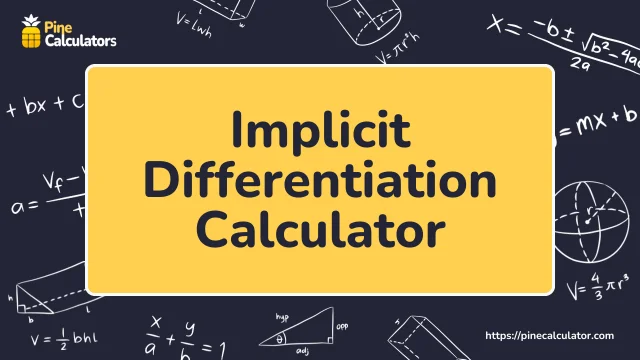Introduction to Implicit Differentiation Calculator:
Implicit differentiation calculator is an online tool that helps you to find the differentiation of a function, with more than one independent variable. It means you evaluate the complex implicit function that cannot recognize dependent or independent variable.

It is an essential tool for students and professionals, dealing with complicated implicit function equations. The dy/dx calculator simplifies the differentiation process and gives you accurate results.
What is Implicit Differentiation?
Implicit differentiation function is a differential process to find the derivative of a dependent variable with the function which is not expressed in the form y = f(x).
In implicit differentiation method, you take the variable that is hard to find from the rest derivation equation. If y is isolated from the given expression, then take the derivative otherwise separate the value of x and take the derivative with respect to x.
How to Find the Implicit Differentiation?
To find the implicit differentiation function you need to follow simple steps for understanding the process of implicit differentiation in detail.
Step 1:
Determine the implicit function in the form of y = f(x).
Step 2:
Simplify the given function and separate the x and y to make differential process smooth.
Step 3:
Evaluate the differentiation of implicit function with respect to x.
Step 4:
After evaluation, simplify the implicit function y = f(x) to get a solution.
Example of Implicit Differentiation:
An example of implicit differentiation function y = f(x) will help you to understand the calculation process of implicit differentiation calculator.
Example:
Assume that y is defined implicitly by the following equation,
$$ x^3 sin\; y + y \;=\; 4x + 3 \;find\; \frac{dy}{dx} $$
Solution:
Identify the given function,
$$ x^3 sin\; y + y \;=\; 4x + 3 $$
As you can see x and y values are separated already so you don't need to change them,
$$ x^3 sin\; y + y \;=\; 4x + 3 $$
Differentiate with respect to x (both sides),
$$ \frac{d}{dx} (x^3 sin\; y) + \frac{d}{dx}(y) \;=\; 4 $$
Simplify the above expression,
$$ \left( \frac{d}{dx}(x^3) . sin\; y + \frac{d}{dx}(sin\; y) . x^3 \right) + \frac{dy}{dx} \;=\; 4 $$
$$ 3x^2 sin\; y + (cos\; y \frac{dy}{dx}) . x^3 + \frac{dy}{dx} \;=\; 4 $$
$$ x^3 cos\; y \frac{dy}{dx} + \frac{dy}{dx} \;=\; 4 - 3x^2 sin\; y $$
The differential function is separated from the rest:
$$ \frac{dy}{dx} (x^3 cos\; y + 1) \;=\; 4 - 3x^2 sin\; y $$
$$ \frac{dy}{dx} \;=\; \frac{4 - 3x^2 sin\; y}{x^3 cos\; y + 1} $$
How to Use the Implicit Derivative Calculator?
The dy/dx calculator has a simple design that helps you to solve the differential function immediately. Just follow the given steps to put the values accurately.
- Enter the implicit function in the input box of implicit differential calculator with steps.
- Add the variable of differentiation in the input field for the given implicit function.
- Check your given implicit function to get the exact solution of implicit differential question.
- Click on the Calculate button to get the result of implicit derivative problems.
- If you want to check the working process of implicit derivative at a point calculator then you can use the load example option.
- Click on the “Recalculate” button for the calculation of more examples of implicit functions.
Outcome from Implicit Differentiation Calculator with Steps:
Implicit differentiation derivative calculator provides you the solution as per your input problem when you click on the calculate button. It includes as:
Result Box:
Click on the result button so you get the solution of your implicit derivative question.
Steps Box:
When you click on the steps option, you get the result of implicit differentiation function in steps.
Benefits of Derivative Calculator Implicit:
Implicit derivative calculator have many advantages. When you use it, you get the solution of implicit derivation function. The advantages are:
- Implicit differentiation calculator is a trustworthy tool as it provides you accurate solutions of implicit derivative functions.
- It is a learning tool that provides you in depth knowledge of implicit derivative function very easily.
- Implicit derivative at a point calculator is an efficient tool that provides solutions of implicit function problems.
- It is a handy tool that evaluates complicated implicit differential function problems quickly without manual calculation.
- Implicit differentiation derivative calculator is a free tool that allows you to calculate implicit derivation function questions for free.
- dy/dx calculator is an easy-to-use tool, anyone or even a beginner can easily use it for getting the solution of implicit differential problems.










